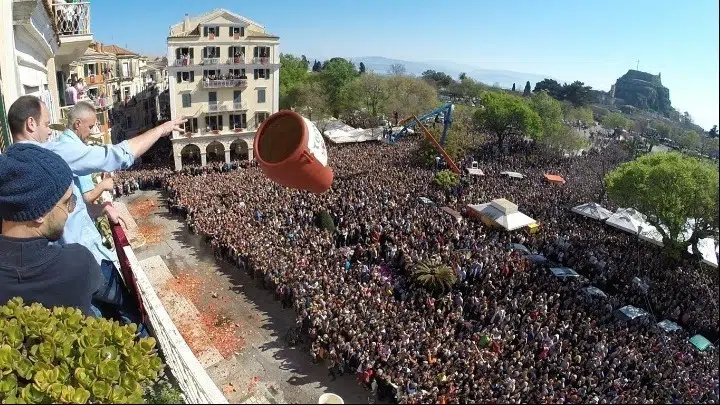
With Greek Orthodox Easter on May 5, Greeks and tourists alike are planning to rush out of urban centers to enjoy the unique holiday customs found in destinations across the country.
While there are some shared Easter traditions throughout the country, there are many distinct customs that are unique to specific locations. Many of these traditions are incredibly moving, spiritual, and visually striking.
For Greeks, Easter is not merely the most important Orthodox holiday but also a time to reconnect with the country’s deep traditions.
Corfu, one of the most popular Easter destinations in Greece
Every Holy Saturday on Corfu, locals revive the old tradition of breaking “botides,” which are a special type of clay pot.
After the First Resurrection, which takes place in the island’s metropolitan church, the bells of all churches begin to toll and people begin throwing thousands of botides filled with water and laurel from their windows.
The botides crash on the road and make a terrible racket, which in combination with the water and laurel is supposed to chase “evil” away.
Easter Sunday is filled with music from the island’s numerous bands which march around the city center playing songs. This joyous and beautiful event alone attracts thousands of Greek tourists each year.
Other Greek islands with unique Easter traditions have become popular destinations. Hydra is a popular choice due to its proximity to Athens and its tradition of blessing an Epitaph from the region of Kamini and then placing it in the sea, following a long procession throughout the island.
Many travellers are also rushing to the island of Chios, which is famed for its unique and spectacular Easter tradition of launching rockets.
The rocket war, one of the most beautiful, spectacular and yet dangerous Easter spectacles in the country, is thought to date back to the days of the Ottoman occupation of Greece.
The custom traditionally involves two opposing parishes of the village spending the evening just before Orthodox Easter Sunday firing thousands of homemade rockets at each other’s church, while the more pious among them attend a service inside.
The two rival parishes are Saint Mark and Panagia Erythiani (which means ”Red Madonna” in English).
These two beautiful churches stand on two hilltops about 400 meters from each other.
Traditionally, the objective is to hit the bell tower of the church on the other side. The rockets are wooden sticks loaded with an explosive mixture containing gunpowder and launched from grooved platforms.
Areas of religious significance also popular
Many destinations that are known internationally for their religious significance are also popular choices for Easter. The most notable and popular are the Greek islands of Patmos and Tinos.
Patmos, also known as the “Island of the Apocalypse,” is best known as the location where the Apostle John, who found refuge on the island in the 1st century AD, saw the visions found in the Book of Revelation in the New Testament, and where the book itself was written.
The Book of Revelation was written in 95 AD in the Holy Cave of the Apocalypse, where Saint John heard the voice of God.
The cave was later turned into a place of worship, and it is still open to travelers who are often Christians going on pilgrimage.
Each Easter, believers on the Greek island reenact two important scenes from the New Testament, namely the Last Supper and the Washing of the Feet, in the island’s central square.
Tinos is a holy island both for Greek Orthodox believers and for Catholics, as the island is home to a significant population of Greek Catholics who coexist peacefully with their Orthodox neighbors. The two groups often combine their holiday celebrations, showing their unity, even though the dates of Catholic and Orthodox Easter don’t often coincide.
On Good Friday, single women on the island bless the Epitaph of Agios Nikolaos which is then led to the sea in a procession. The Epitaph blazes with fire from burning torches that are used during the tradition.
Of course, Tinos is also known for the famous church called Our Lady of Tinos (Greek: Παναγία Ευαγγελίστρια της Τήνου), which is home to an Icon of the Virgin Mary that is said to be miraculous.
Meteora, which is known internationally for its impressive, moon-like landscapes and historic monasteries, is a popular destination for Easter time, as the faithful can visit the holy places and admire the stunning scenery.
Located near the town of Kalabaka at the northwestern edge of the Plain of Thessaly near the Pineios river and Pindus Mountains, Meteora is included on the UNESCO World Heritage List.
Now home to one of the largest—and certainly the most precipitously built—complexes of Eastern Orthodox monasteries, Meteora is second in importance only to Mount Athos in religious centers of Orthodox monasticism.
See all the latest news from Greece and the world at Greekreporter.com. Contact our newsroom to report an update or send your story, photos and videos. Follow GR on Google News and subscribe here to our daily email!



